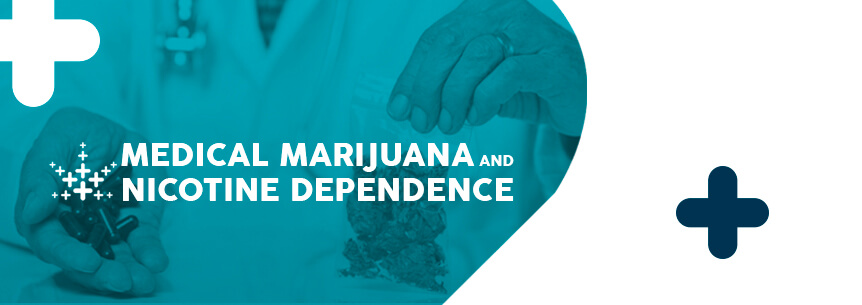
Just like with any other addiction, nicotine dependence and withdrawal can wreak havoc on patients’ mental health. Common side effects of nicotine withdrawal are mood swings that emerge into low self-esteem, isolation, and feelings of worthlessness. Medical marijuana and nicotine dependence treatment can help alleviate these and other symptoms associated with nicotine dependence, so you can quit your nicotine habit more comfortably and get on with your life.
Nicotine is a type of chemical containing nitrogen. Several species of plants make nitrogen, including the tobacco plant. Tobacco is also manufactured synthetically. You can find nicotine in small amounts in eggplants, potatoes, and tomatoes, but this alkaloid has a much higher degree in the tobacco plant. Researchers and scientists have been studying the effect nicotine has on the body systems and brain extensively.
Nicotine dependence is the addiction to tobacco products due to them containing the drug nicotine. Nicotine dependence is where you can’t stop using the product or substance, even though you know it’s harming you.
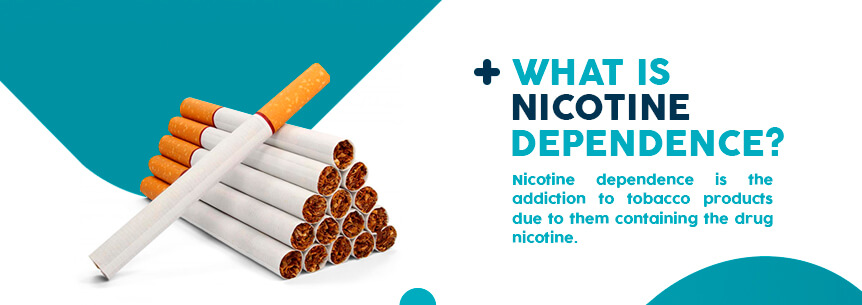
Nicotine produces mood-altering and physical effects in your brain you find temporarily pleasurable. These effects cause you to “want” to continue using tobacco, which results in dependence. Stopping smoking, however, can cause unpleasant withdrawal symptoms like anxiety and irritability.
While nicotine is what causes nicotine dependence in tobacco, tobacco’s toxic effects come from other substances found in tobacco. Individuals who smoke also have higher rates of stroke, heart disease, and cancer than those who don’t smoke.
No matter how long you’ve been smoking, quitting can improve your well-being and health. Your doctor can help you quit smoking by recommending specific effective treatments to manage the withdrawal as you get over your nicotine dependence.
For some individuals, using even small amounts of tobacco can result in nicotine dependence quickly. Signs you might have an addiction are:
Nicotine is highly addictive when you inhale the tobacco smoke into your lungs because this delivery system rapidly releases nicotine into your blood enabling it to reach your brain within seconds of smoking that puff. Nicotine increases your brain’s neurotransmitters — brain chemicals — that help to regulate behavior and mood.
The release of one of these neurotransmitters, dopamine, into your brain’s “reward center” causes improved feelings of pleasure and mood. It’s these effects you feel from the nicotine that cause tobacco to be addictive.
Nicotine dependence involves physical and behavioral — habits, routines, feelings, etc. — factors. These behavioral factors with smoking could be acting as triggers — certain emotions or situations activate a tobacco craving, even if it’s been a while since you smoked.
Cues and behaviors you may associate with smoking could include:
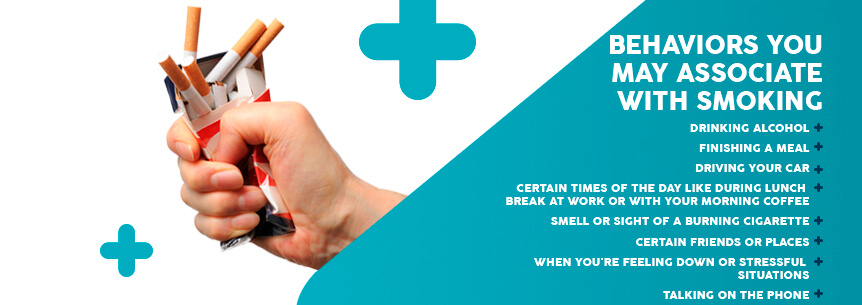
To overcome tobacco dependence, you need to learn your triggers and come up with an action plan on how you’ll deal with the routines and behaviors you associate with smoking.
The effects nicotine has on you will depend on how it enters your body. Therefore, you should take a moment to learn the different forms of tobacco before moving on to how nicotine dependence develops.
For centuries, individuals have been using tobacco in a variety of forms. Historically, people smoked it in pipes or chewed it. These days, manufactured cigarettes are the most common tobacco use method.
Generally, you can categorize tobacco products into two forms: combustible (you smoke the tobacco) or non-combustible (mainly different types of snuff and chewing tobacco).
Combustible tobacco, or smoked forms, include:
Smokeless tobacco forms include:
Around one in five deaths yearly in the U.S. are due to tobacco use. Smoking can damage just about all your body systems and may cause:
Even adult non-smokers and children can experience disease or premature death because of second-hand smoke. Children with second-hand smoke exposure have a higher risk of sudden infant death syndrome (SIDS) and might also develop:
Adults with second-hand smoke exposure have a higher risk of developing lung cancer and coronary heart disease. Second-hand smoke could also immediately affect your cardiovascular system negatively.
Individuals with an addiction who go a little while without smoking could experience nicotine withdrawal symptoms. Withdrawal presents a continuous sequence of symptoms that increase in severity rapidly described by addicted individuals as “wanting,” “craving” and gradually “needing” to smoke.
These symptoms might then turn into:
Escalating withdrawal symptoms generate a smoking compulsion that makes quitting difficult. The core characteristic of nicotine dependence is this compulsion to smoke, accounting for its physiological characteristics, behavioral manifestations, clinical course, and prognosis.
You can develop a compulsion quickly. Initially, one cigarette can hold off withdrawal for weeks, but with the progression of the addiction, you must smoke cigarettes at progressively shorter intervals to subdue symptoms of withdrawal.
Nicotine dependence can bring about certain psychological effects, as well, such as:
According to the National Institutes of Health, facts about nicotine dependence include:
The tobacco plant is native to the Americans — they used it as a stimulant and medicine for a minimum of 2000 years. It’s not clear who tobacco first arrived in Europe. However, it’s often thought Christopher Columbus discovered the plant for the first time while exploring the Americas.
The smoking of cigars and pipes quickly spread throughout the 1600s. When first introduced to Europe, some saw tobacco as habit-forming and toxic, while others saw it as medicinal.
Growing throughout the 1700s, the tobacco industry exploded in 1880 when a device was first patented for mass-producing paper cigarettes. From that point on, cigarettes were much easier to make.
Dealing with the physical aspect of nicotine dependence can be difficult. You must work hard to change your routines and behaviors to be successful. There are a variety of options of treatment for nicotine addiction, including nicotine replacement therapy, medication and support groups.
Your doctor can prescribe or recommend certain medicines to help you quit smoking. These medications work by lessening your cravings. Nicotine replacement therapy is one option that comes in different forms, such as:
They provide you with nicotine, but not the other harsh chemicals tobacco contains. They help you to beat your addiction gradually and methodically.
You’ll also find non-nicotine options like antidepressants. Antidepressants increase the production of dopamine to improve your mood.
Whether you choose a virtual support group or an in-person one, these can help you work through your nicotine dependence, teach you coping skills and offer you fellowship with other individuals going through the same thing as you.
Nicotine dependence treatment focuses mostly on medicines, working through symptoms of withdrawal and learning coping skills. Here are some ways to help while you’re making this transition away from nicotine:
Some natural and alternative remedies to help you get past your addiction might include:
The efficacy and safety of these options aren’t clear, however.
Clinical trials for nicotine withdrawal include:
Clinical trials for nicotine dependence include:
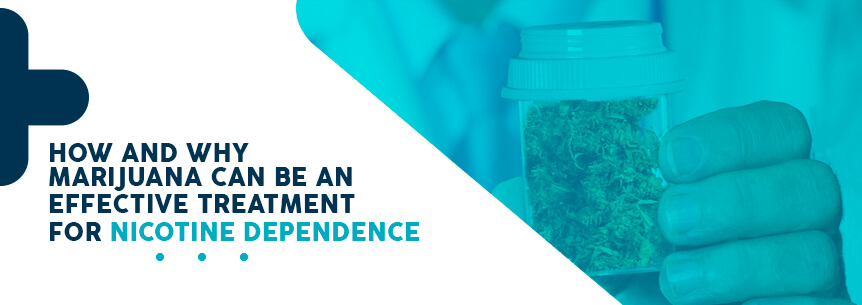
Marijuana has long been considered an addictive substance itself. But, this is changing. Studies are now showing the herb is far less addictive than many other illicit and legal substances.
A study indicates cigarette smoking can mediate the link between marijuana use and marijuana dependence, with tobacco being the partial drive of weed dependence in younger individuals who use marijuana and tobacco. However, studies are now showing CBD — one of marijuana’s primary cannabinoids — might help minimize addictive behavior and curb addiction, even nicotine addiction.
Your brain has a dopamine-based reward system, as we mentioned above. Dopamine is a potent brain chemical that can generate cravings in your mind. Initially, these cravings were created to help us survive and included food, social interaction, and sex.
You experience sensations of pleasure once you give in to these cravings. Dopamine triggers cravings at first when it starts to flow through a complex pathway connecting these different brain areas. Dopamine first travels from your brainstem to your dorsal striatum, where brain neurons identify rewarding experiences, such as:
You then start developing habits — or a routine — out of them. CBD for nicotine addiction can help curb these habits.
A study in 2013 on addictive behaviors showed the CBD in medical cannabis for nicotine dependence helped to reduce smokers’ tobacco consumption. A total of 24 smokers in the study were looking to quit and randomly chosen to receive either a placebo or a CBD inhaler for one week. They were instructed to use the inhaler each time they had a craving to smoke a cigarette.
During the week of treatment, the smokers using the placebo inhaler didn’t show any difference in how many cigarettes they smoked. However, individuals using the CBD inhaler showed a significant (40 percent) decrease in how many cigarettes they smoked.
Side effects of cannabis and nicotine dependence treatment are:
Marijuana for nicotine dependence can help with symptoms such as:
Some good strains to help with the adverse mood side effects of addiction are:
The best strains to ward off headaches associated with nicotine withdrawal are:
Strains that help with panic attacks include:
Some strains that help with sleep troubles are:
Finding the right marijuana and nicotine dependence strain to treat your nicotine dependence may take some experimenting. If you’re not finding the relief you’re looking for with one strain, try another one.
As marijuana users are becoming more aware of the harm smoking can cause, many of them are looking for methods to replace cannabis smoking. One particular way is vaping — smoking involves combustion, while vaping doesn’t.
Despite this, almost 90 percent of marijuana users still prefer to smoke the herb — even though they know vaporizing can reduce this harm effectively.
Along with vaping and smoking, other methods of cannabis use include:
There’s no need for you to stay addicted to nicotine or suffer through the withdrawals of quitting. As more states begin legalizing medical weed, you’ll start seeing more and more dispensaries opening their doors to help you with your cannabis product needs.
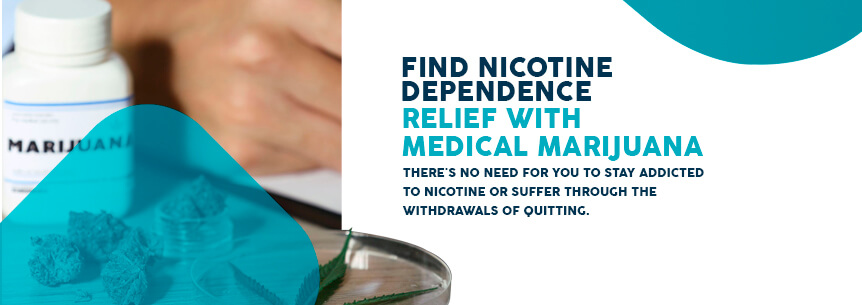
But, since so many dispensaries are already out there for you to choose from, it can become overwhelming to decide which one is most reputable. Plus, you need the recommendation from a qualified doctor to even begin cannabis for nicotine dependence. Fortunately, you can find a qualified marijuana doctor and reputable dispensary to buy your cannabis products all in one place: right here at MarijuanaDoctors.com. Browse our extensive site and book your appointment with a marijuana-friendly physician near you today.
Find A Doctor Find A Dispensary